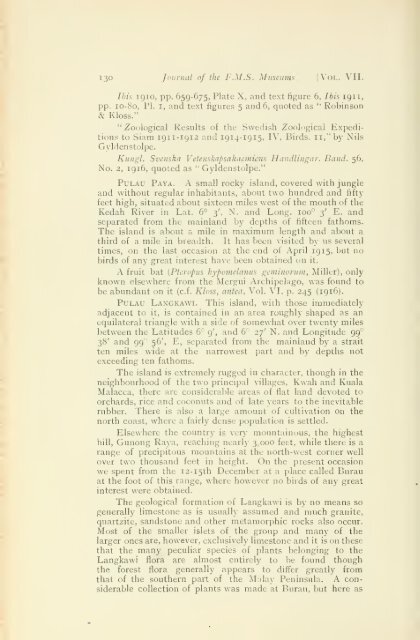Journal of the Federated Malay States museums - Sabrizain.org
Journal of the Federated Malay States museums - Sabrizain.org
Journal of the Federated Malay States museums - Sabrizain.org
You also want an ePaper? Increase the reach of your titles
YUMPU automatically turns print PDFs into web optimized ePapers that Google loves.
130 <strong>Journal</strong> <strong>of</strong> <strong>the</strong> F.M.S. Museums. [Vol. VII,<br />
Ibis igio, pp. 659-675, Plate X, and text figure 6, Ibis 1911,<br />
pp. 10-S0, PI. 1, and text figures 5 and 6, quoted as " Robinson<br />
& Kloss."<br />
"Zoological Results <strong>of</strong> <strong>the</strong> Swedish Zoological Expeditions<br />
to Siarn 1911-1912 and 1914-1915, IV, Birds, n," by Nils<br />
Gyldenstolpe.<br />
Kttngl. Svenska Vetenskapsakaemiens Handlingar. Band. 56,<br />
No. 2, 1916, quoted as "Gyldenstolpe."<br />
Pulau Paya. A small rocky island, covered with jungle<br />
and without regular inhabitants, about two hundred and fifty<br />
feet high, situated about sixteen miles west <strong>of</strong> <strong>the</strong> mouth <strong>of</strong> <strong>the</strong><br />
Kedah River in Lat. 6° 3', N. and Long. ioo° 3' E. and<br />
separated from <strong>the</strong> mainland by depths <strong>of</strong> fifteen fathoms.<br />
The island is about a mile in maximum length and about a<br />
third <strong>of</strong> a mile in breadth. It has been visited by us several<br />
times, on <strong>the</strong> last occasion at <strong>the</strong> end <strong>of</strong> April 1915, but no<br />
birds <strong>of</strong> any great interest have been obtained on it.<br />
A fruit bat [Pteropus hypomelanus geminorum, Miller), onlyknown<br />
elsewhere from <strong>the</strong> Mergui Archipelago, was found to<br />
be abundant on it (c.f. Kloss, antea, Vol. VI, p. 245 (1916).<br />
Pulau Langkawi. This island, with those immediately<br />
adjacent to it, is contained in an area roughly shaped as an<br />
equilateral triangle with a side <strong>of</strong> somewhat over twenty miles<br />
between <strong>the</strong> Latitudes 6° 9', and 6° 27' N. and Longitude 99<br />
38' and 99° 56', E, separated from <strong>the</strong> mainland by a strait<br />
ten miles wide at <strong>the</strong> narrowest part and by depths not<br />
exceeding ten fathoms.<br />
The island is extremely rugged in character, though in <strong>the</strong><br />
neighbourhood <strong>of</strong> <strong>the</strong> two principal villages. Kwah and Kuala<br />
Malacca, <strong>the</strong>re are considerable areas <strong>of</strong> flat land devoted to<br />
orchards, rice and coconuts and <strong>of</strong> late years to <strong>the</strong> inevitable<br />
rubber. There is also a large amount <strong>of</strong> cultivation on <strong>the</strong><br />
north coast, where a fairly dense population is settled.<br />
Elsewhere <strong>the</strong> country is very mountainous, <strong>the</strong> highest<br />
hill, Gunong Raja, reaching nearly 3,000 feet, while <strong>the</strong>re is a<br />
range <strong>of</strong> precipitous mountains at <strong>the</strong> north-west corner well<br />
over two thousand feet in height. On <strong>the</strong> present occasion<br />
we spent from <strong>the</strong> I2-I5th December at a place called Burau<br />
at <strong>the</strong> foot <strong>of</strong> this range, where however no birds <strong>of</strong> any great<br />
interest were obtained.<br />
The geological formation <strong>of</strong> Langkawi is by no means so<br />
generally limestone as is usually assumed and much granite,<br />
quartzite, sandstone and o<strong>the</strong>r metamorphic rocks also occur.<br />
Most <strong>of</strong> <strong>the</strong> smaller islets <strong>of</strong> <strong>the</strong> group and many <strong>of</strong> <strong>the</strong><br />
larger ones are, however, exclusively limestone and it is on <strong>the</strong>se<br />
that <strong>the</strong> many peculiar species <strong>of</strong> plants belonging to <strong>the</strong><br />
Langkawi flora are almost entirely to be found though<br />
<strong>the</strong> forest flora generally appears to differ greatly from<br />
that <strong>of</strong> <strong>the</strong> sou<strong>the</strong>rn part <strong>of</strong> <strong>the</strong> <strong>Malay</strong> Peninsula. A considerable<br />
collection <strong>of</strong> plants was made at Burau, but here as
















